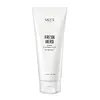What's inside
What's inside
 Key Ingredients
Key Ingredients

 Benefits
Benefits

 Concerns
Concerns

 Ingredients Side-by-side
Ingredients Side-by-side

Water
Skin ConditioningGlycerin
HumectantMyristic Acid
CleansingLauric Acid
CleansingPotassium Hydroxide
BufferingPropylene Glycol Laurate
Skin ConditioningPalmitic Acid
EmollientGlyceryl Stearate
EmollientPEG-32
HumectantStearic Acid
CleansingCocamidopropyl Betaine
CleansingPEG-100 Stearate
Calendula Officinalis Flower Water
MaskingPropolis Extract
Skin ConditioningSodium Hyaluronate
HumectantCitrus Aurantium Bergamia Fruit Oil
MaskingPelargonium Graveolens Flower Oil
MaskingLavandula Hybrida Oil
EmollientCananga Odorata Flower Oil
MaskingSodium Chloride
MaskingPolyquaternium-7
Arachidic Acid
CleansingPEG-90m
Emulsion StabilisingSodium Benzoate
MaskingSilica
AbrasiveButylene Glycol
HumectantDisodium EDTA
Phenoxyethanol
PreservativeChlorphenesin
AntimicrobialCaprylyl Glycol
EmollientEthylhexylglycerin
Skin Conditioning1,2-Hexanediol
Skin ConditioningWater, Glycerin, Myristic Acid, Lauric Acid, Potassium Hydroxide, Propylene Glycol Laurate, Palmitic Acid, Glyceryl Stearate, PEG-32, Stearic Acid, Cocamidopropyl Betaine, PEG-100 Stearate, Calendula Officinalis Flower Water, Propolis Extract, Sodium Hyaluronate, Citrus Aurantium Bergamia Fruit Oil, Pelargonium Graveolens Flower Oil, Lavandula Hybrida Oil, Cananga Odorata Flower Oil, Sodium Chloride, Polyquaternium-7, Arachidic Acid, PEG-90m, Sodium Benzoate, Silica, Butylene Glycol, Disodium EDTA, Phenoxyethanol, Chlorphenesin, Caprylyl Glycol, Ethylhexylglycerin, 1,2-Hexanediol
Water
Skin ConditioningCoco-Betaine
CleansingSodium Lauroyl Methyl Isethionate
CleansingArginine
MaskingSodium Chloride
MaskingBetaine
HumectantAcrylates/C10-30 Alkyl Acrylate Crosspolymer
Emulsion StabilisingHydroxyacetophenone
AntioxidantSodium Methyl Isethionate
EmulsifyingLauric Acid
CleansingCentella Asiatica Extract
CleansingSodium Laurate
CleansingMelaleuca Alternifolia Leaf Oil
AntioxidantEthylhexylglycerin
Skin ConditioningAllantoin
Skin ConditioningDisodium EDTA
1,2-Hexanediol
Skin ConditioningWater, Coco-Betaine, Sodium Lauroyl Methyl Isethionate, Arginine, Sodium Chloride, Betaine, Acrylates/C10-30 Alkyl Acrylate Crosspolymer, Hydroxyacetophenone, Sodium Methyl Isethionate, Lauric Acid, Centella Asiatica Extract, Sodium Laurate, Melaleuca Alternifolia Leaf Oil, Ethylhexylglycerin, Allantoin, Disodium EDTA, 1,2-Hexanediol
 Reviews
Reviews

Ingredients Explained
These ingredients are found in both products.
Ingredients higher up in an ingredient list are typically present in a larger amount.
1,2-Hexanediol is a synthetic liquid and another multi-functional powerhouse.
It is a:
- Humectant, drawing moisture into the skin
- Emollient, helping to soften skin
- Solvent, dispersing and stabilizing formulas
- Preservative booster, enhancing the antimicrobial activity of other preservatives
Disodium EDTA plays a role in making products more stable by aiding other preservatives.
It is a chelating agent, meaning it neutralizes metal ions that may be found in a product.
Disodium EDTA is a salt of edetic acid and is found to be safe in cosmetic ingredients.
Learn more about Disodium EDTAEthylhexylglycerin (we can't pronounce this either) is commonly used as a preservative and skin softener. It is derived from glyceryl.
You might see Ethylhexylglycerin often paired with other preservatives such as phenoxyethanol. Ethylhexylglycerin has been found to increase the effectiveness of these other preservatives.
Lauric Acid is a fatty acid or lipid. About half of fatty acids in coconut oil is lauric acid.
This ingredient helps hydrate and sooth skin. As a humectant, it helps trap moisture. It also aids in cleaning and enhancing the texture of products.
Lauric acid may not be Malassezia folliculitis, or fungal acne, safe.
Learn more about Lauric AcidChances are, you eat sodium chloride every day. Sodium Chloride is also known as table salt.
This ingredient has many purposes in skincare: thickener, emulsifier, and exfoliator.
You'll most likely find this ingredient in cleansers where it is used to create a gel-like texture. As an emulsifier, it also prevents ingredients from separating.
There is much debate on whether this ingredient is comedogenic. The short answer - comedogenic ratings don't tell the whole story. Learn more about comegodenic ratings here.
The concensus about this ingredient causing acne seems to be divided. Research is needed to understand if this ingredient does cause acne.
Scrubs may use salt as the primary exfoliating ingredient.
Learn more about Sodium ChlorideWater. It's the most common cosmetic ingredient of all. You'll usually see it at the top of ingredient lists, meaning that it makes up the largest part of the product.
So why is it so popular? Water most often acts as a solvent - this means that it helps dissolve other ingredients into the formulation.
You'll also recognize water as that liquid we all need to stay alive. If you see this, drink a glass of water. Stay hydrated!
Learn more about Water